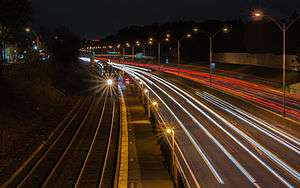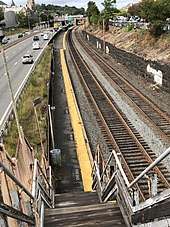Newtonville station
Newtonville station is a commuter rail station on the MBTA Commuter Rail Framingham/Worcester Line, located between the Massachusetts Turnpike and Washington Street at Newtonville Square in the village of Newtonville in Newton, Massachusetts. Stairway entrances are located on the bridges over the Turnpike at Walnut Street and Harvard Street. Newtonville station is not accessible.
Newtonville | |||||||||||||
|---|---|---|---|---|---|---|---|---|---|---|---|---|---|
 An outbound train arriving at Newtonville at night | |||||||||||||
| Location | 770 Washington Street Newtonville, Massachusetts | ||||||||||||
| Coordinates | 42°21′06″N 71°12′19″W | ||||||||||||
| Owned by | MBTA | ||||||||||||
| Line(s) | Worcester Line | ||||||||||||
| Platforms | 1 side platform | ||||||||||||
| Tracks | 2 | ||||||||||||
| Connections | |||||||||||||
| Construction | |||||||||||||
| Parking | 53 spaces ($0.75/hr) | ||||||||||||
| Bicycle facilities | Non-MBTA rack available on Washington Street | ||||||||||||
| Disabled access | No | ||||||||||||
| Other information | |||||||||||||
| Fare zone | 1 | ||||||||||||
| History | |||||||||||||
| Opened | 1842[1] | ||||||||||||
| Previous names | Hull's Crossing[2] | ||||||||||||
| Traffic | |||||||||||||
| Passengers (2018) | 476 (weekday average boardings)[3] | ||||||||||||
| Services | |||||||||||||
| |||||||||||||
| |||||||||||||
History

Hulls Crossing station opened as a flag stop on the Boston and Worcester Railroad in 1842.[1] It was first located on the south side of the tracks on the west side of Harvard Street, then later moved to the east side.[4][5] The first station agent, Joshua Ramsdell, worked at Newtonville from 1844 to 1889, by which time he was "probably the oldest station agent in New England".[6]
A red brick station was constructed slightly to the east in the 1870s, one of a small number of B&A stations built that decade.[7] It ultimately became the first stop outside Boston for long-distance trains on the Boston and Albany Railroad.[8][9] After Amtrak took over intercity service in 1971, the Bay State briefly stopped at Newtonville.[10]
The present station has one active side platform next to the southern track (Turnpike side); trains on the other track can be boarded via a wooden crossing, as is occasionally done when the southern track is closed for repairs. A second platform, now abandoned, sits aside the northern track. Both platforms are low level.
Accessibility plans

None of the stations on the Framingham line in Newton—Newtonville, West Newton and Auburndale—are handicapped accessible. All have only one active platform, all low-level, and all are accessed by lengthy stairs. The MBTA has proposed three alternative plans to make the Newton stations accessible, so as to comply with the Americans with Disability Act. Plan 1 would add a high level platform on only one track, would cost an estimated $46 million and would take five years to complete. Plan 2 would have high-level side platforms on both tracks, would cost $129 million and take 8 years. The platform on the north side would be built first and used for service while the south platform was rebuilt. Plan 1 could be upgraded to Plan 2 at a later date. All stations would remain in service during construction of both plans. A more elaborate plan 3 would cost 218 million.[11] Plan 3 would have center island platforms at each station and would take 12 years. Each station would have to be closed during its construction. Plans 2 and 3 would permit increased service to Newton, up to 20 inbound trains per day vs the current and Plan 1 limit of 13.[12]
The MBTA opted for Alternative 1, providing a single side platform at each station, and awarded a design contract to Vanasse Hangen Brustlin. The projected timeline has all stations being complete by June 2024.[13]
On October 22, 2019, the station was temporarily closed while repairs were made to the stairs.[14][15] The station reopened on October 25.[16]
Bus connections
Newtonville is served by one local MBTA bus route on Walnut Street, and three express routes on Washington Street:
- 59: Needham Junction–Watertown Square
- 553: Roberts–Federal Street & Franklin Street
- 554: Waverly Square–Federal Street & Franklin Street
- 556: Waltham Highlands–Federal Street & Franklin Street
References
- Fleishman, Thelma (1999). Images of America: Newton. Arcadia Publishing. p. 33. ISBN 9780738537740 – via Google Books.
- Burrows, F.W. (January 1909). "The Newtons". New England Magazine. 39 (5): 555.
- Central Transportation Planning Staff (2019). "2018 Commuter Rail Counts". Massachusetts Bay Transportation Authority.
- Woodward, E.F.; Ward, W.F. (April 1848). "Map of the Town of Newton".
- "Part of Newtonville". Atlas of Newton. J.B. Beers & Co. 1874 – via Ward Maps.
- "Our New England Letter". The Station Agent. Vol. 1 no. 6. August 1889. p. 188 – via Google Books.
- Ochsner, Jeffrey Karl (June 1988). "Architecture for the Boston & Albany Railroad: 1881-1894". Journal of the Society of Architectural Historians. 47 (2): 112, 120. doi:10.2307/990324. JSTOR 990324.
- "Newtonville Railroad Station. Boston & Albany Railroad sign. Newton, MA". 19 February 1956 – via Digital Commonwealth.
- "Boston and Albany" (PDF). New York Central Railroad. April 27, 1941. pp. 7–14.
- Nationwide Schedules of Intercity Passenger Service. Amtrak. January 16, 1972. p. 48 – via Museum of Railway Timetables.
- Cohen, Julie M. (July 31, 2019). "Rail plan costs $46M". Newton Tab.
- "Newton commuter rail accessibility". MBTA. July 2019.
- https://cdn.mbta.com/sites/default/files/2019-08/2019-07-25-newton-cr-stations-public-meeting-presentation.pdf
- Saric, Sofia (October 22, 2019). "Newtonville Commuter Rail Station temporarily closed, MBTA says". Boston Globe.
- "Alerts: Commuter Rail". Massachusetts Bay Transportation Authority. Archived from the original on October 23, 2019.
- "Alerts: Commuter Rail". Massachusetts Bay Transportation Authority. Archived from the original on October 25, 2019.
External links
| Wikimedia Commons has media related to Newtonville station. |